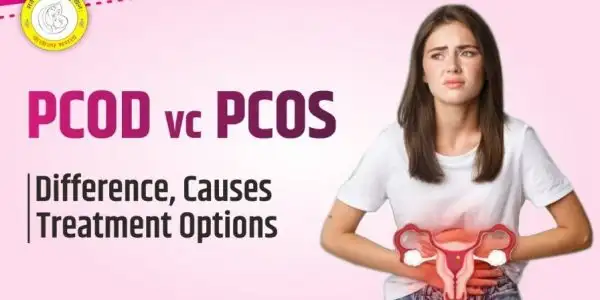Get to know the key Difference between PCOS and PCOD?

In India, there has been an increase in cases of PCOD/PCOS. One in five Indian women suffers from PCOS. These disorders are both common in Indian women as well as women living in other parts of the world. This topic is not as openly discussed as other diseases. It is essential to know the difference between PCOS and PCOD.
We often use PCOS and PCOD interchangeably because they affect the ovaries and can cause hormonal disturbances. But they can be confusing.
What is PCOD? (Polycystic Ovarian Disease)
In this Article
Every month, the ovaries release two eggs in a woman. The ovaries produce tiny amounts of androgens or male hormones. PCOD (Polycystic Ovarian Disease) occurs when the ovaries produce many partially mature or immature eggs that eventually become cysts. The most common symptoms include abdominal weight gain, irregular periods, and male pattern hair loss. This condition causes the ovaries to become larger and produce large quantities of androgens. This can affect a woman’s fertility as well as her body. The best treatment option for PCOD is to reduce its severity.
What is PCOS? (Polycystic Ovary Syndrome)
Women with PCOS (Polycystic Ovary Syndrome) have higher levels of androgen in their ovaries, which can interfere with the development and release of eggs. Cysts are tiny sacs containing a liquid that forms from eggs. These cysts are not released during ovulation. Instead, they build up in the ovaries.
PCOS vs PCOD: 7 Key Differences
1. Fertility Impact
- PCOD: Fertility is often preserved with lifestyle changes.
- PCOS: Major cause of infertility; requires ovulation induction.
2. Pregnancy Risks
- PCOD: Low-risk pregnancy with healthy habits.
- PCOS: High risk of miscarriage, gestational diabetes, and preterm birth.
However, PCOD does not cause infertility. Most women with PCOD can have a normal pregnancy if they make healthy lifestyle changes.
3.Complications
Other than infertility and increased pregnancy risks, PCOS can lead to obesity and diabetes, high blood sugar and low cholesterol, endometrial carcinoma due to delayed ovulation, and non-alcoholic Steatohepatitis (an enlarged or inflamed liver).
4. Long-Term Health Risks
- PCOD: Minor issues like weight gain.
- PCOS: Linked to diabetes, heart disease, and endometrial cancer.
5. Health problems
PCOD is a condition that causes women to experience minor health problems. A woman diagnosed with PCOS may experience high blood pressure, type 2 diabetes, breast cancer, and heart disease.
6. Treatment Approach
- PCOD: Lifestyle changes suffice.
- PCOS: Needs medication (e.g., birth control, anti-androgens).
7. The gravity of symptoms
Both PCOS and PCOD share some similar symptoms. However, PCOS sufferers experience more severe and prominent symptoms. PCOS symptoms are more common in younger women than PCOD.
Also, Read the next article: Most Common Causes Of Female Infertility?
Which is More Dangerous? PCOS or PCOD?
It is possible to think of PCOD as a hormonal imbalance. PCOS, on the other hand, is caused by hormonal imbalances. PCOS is therefore considered to be more dangerous.
Because PCOD is a sign of poor lifestyle choices, regular exercise, meditation, healthier eating habits, and better sleep patterns can help manage it. PCOS is a metabolic disorder that can treat with medical attention and surgery.
Conclusion
While PCOD and PCOS both affect ovarian health, PCOS is a more serious condition needing medical care. Early diagnosis and targeted treatment (lifestyle changes for PCOD, medication for PCOS) are critical. For personalized guidance, consult a top gynecologist in Patna specializing in hormonal disorders.
FAQs
How to confirm PCOS
Blood tests (testosterone, LH/FSH ratio), ultrasound (cysts), and symptom analysis.
How is POS detected
To diagnose PCOS, your doctor will typically:
Conduct a physical exam: Checking for signs like excess hair growth, acne, and weight gain.
Review your medical history: Including menstrual cycles, fertility issues, and family history.
Perform blood tests: To measure hormone levels (like testosterone, LH, and FSH) and rule out other conditions.
Order an ultrasound: To check for enlarged ovaries with small cysts.
PCOS belly shape
There’s no specific “PCOS belly shape.” However, many women with PCOS tend to carry excess weight around their midsection, leading to an apple-shaped body.
Belly fat and PCOS
Many women with PCOS experience belly fat accumulation. While not every woman with PCOS has belly fat, it’s a common symptom. Insulin resistance, often associated with PCOS, can contribute to this.
How to check PCOS in ultrasound report?
An ultrasound report for PCOS will typically show:
Enlarged ovaries: Larger than normal ovaries.
Polycystic ovaries: Presence of multiple small cysts on the ovaries.
Thickened uterine lining: This might be present if you have irregular periods.
Note: An ultrasound alone cannot confirm PCOS. It’s one part of the diagnostic process.
PCOD or PCOS which is more dangerous
PCOS is more serious than PCOD. It involves hormonal imbalances and can lead to long-term health issues like diabetes and heart disease.
Difference between PCOS and PCOD symptoms
There’s no significant difference between PCOS and PCOD symptoms. Both terms refer to the same condition. The symptoms typically include irregular periods, excess androgen (male hormone) levels, and polycystic ovaries.
Remember: If you’re experiencing symptoms of PCOS, it’s essential to consult a healthcare professional for an accurate diagnosis and appropriate treatment.



